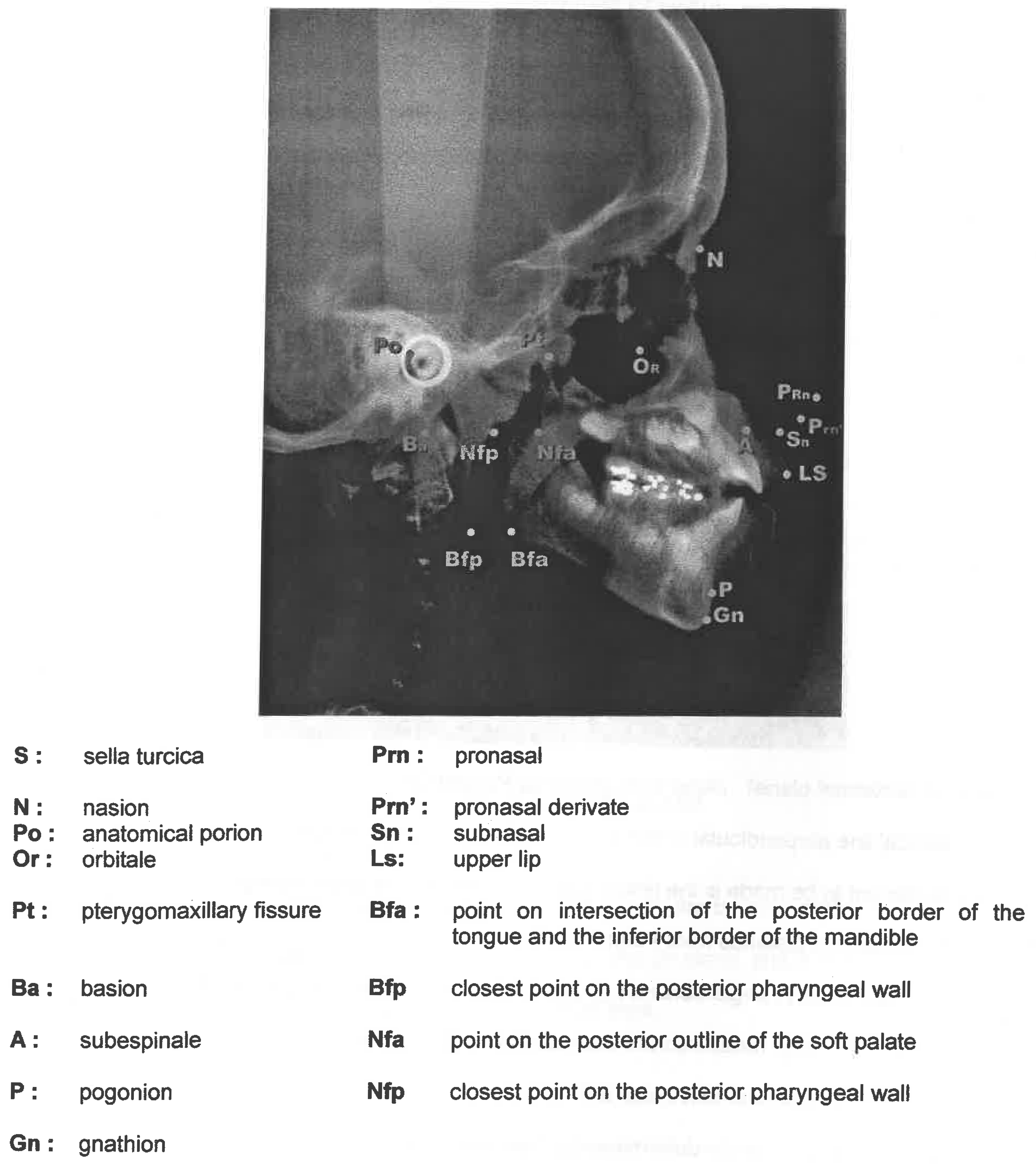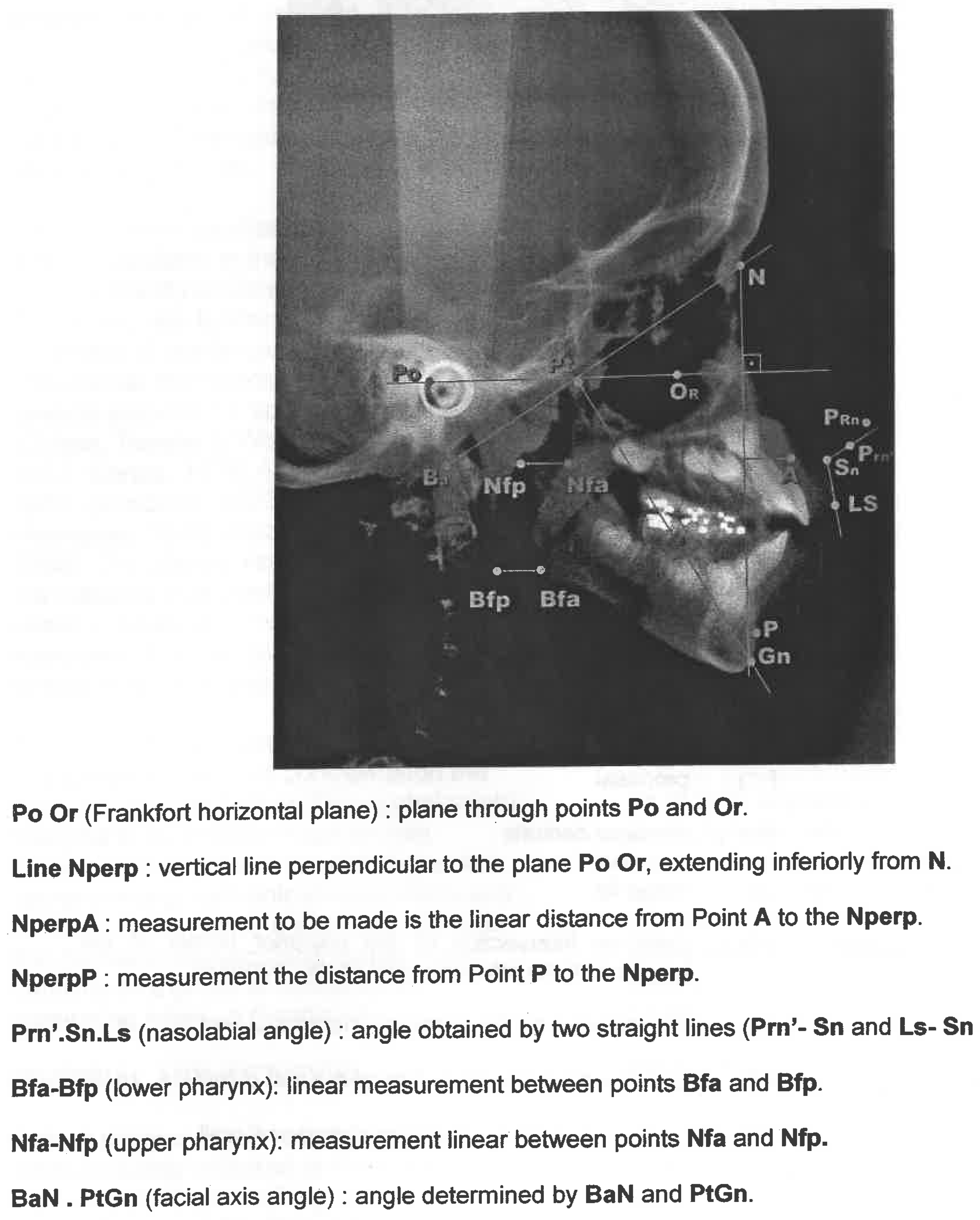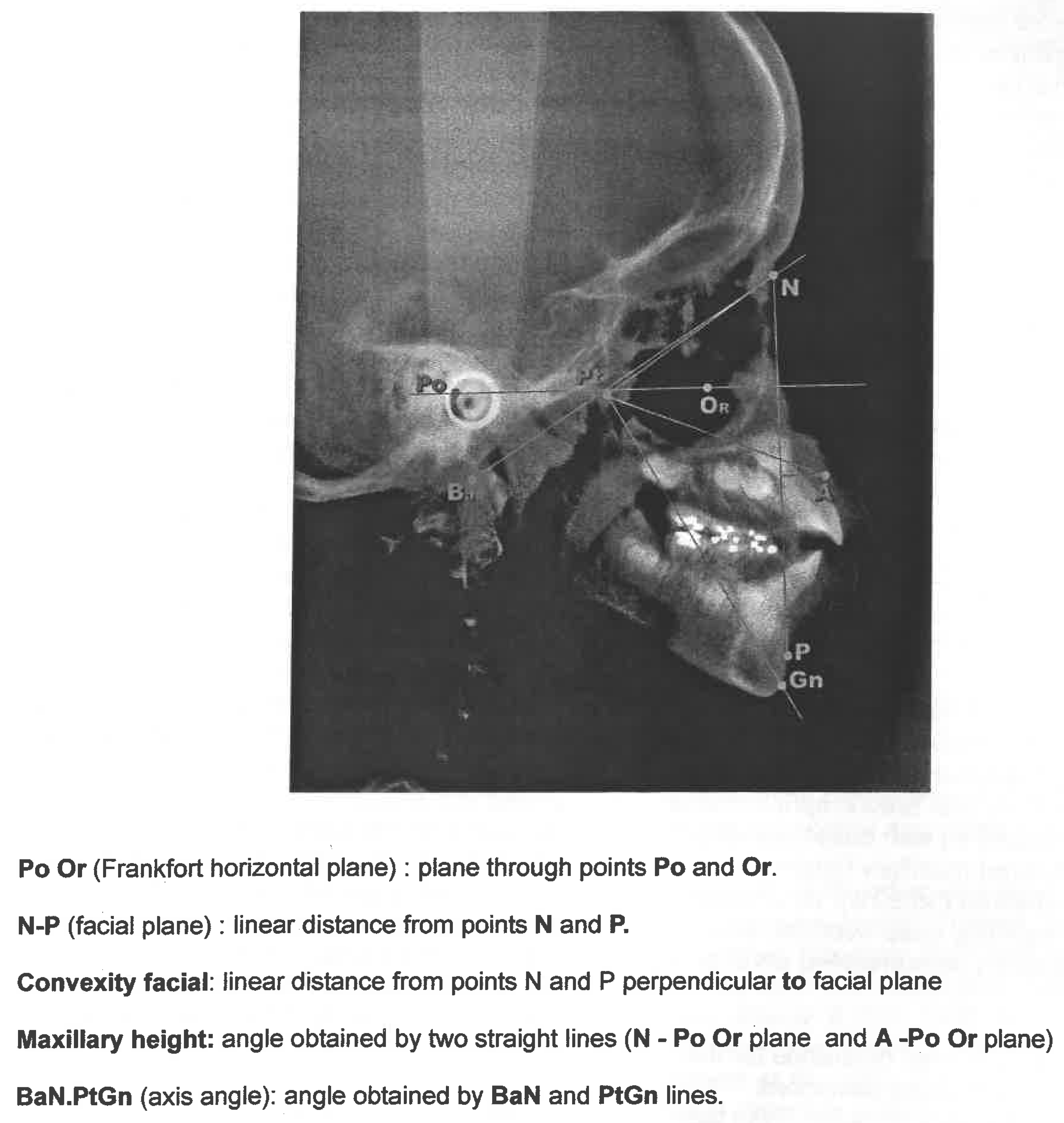Cephalometric Evaluation in Children Presenting Adapted Swallowing During Mixed Dentition
Abstract
:INTRODUCTION
MATERIAL AND METHODS
RESULTS



DISCUSSION
CONCLUSION
References
- Alexander, T. L., and H. P. Hitchcock. 1978. Cephalometric standards for American Negro children. American Journal of Orthodontics 74, 3: 298–304. [Google Scholar] [PubMed]
- Altemus, L.A. 1960. A comparison of cephalofacial relationships. Angle Orthodontist 30, 4: 223–40. [Google Scholar]
- Altemus, L.A. 1963. Comparative integumental relationships. Angle Orthodontist 33, 3: 217–21. [Google Scholar]
- Altemus, L. A. 1968. Cephalofacial relationships. Angle Orthodontist 38, 3: 175–84. [Google Scholar]
- Andersen, W. S. 1963. The relationship of the tongue thrust syndrome to maturation and other factors. American Journal of Orthodontics 49, 4: 264–75. [Google Scholar]
- Angle, E. H. Classification of malocclusion. Dental Cosmos 41, 18: 248–64.
- Barrow, G. V., and J. R. White. 1952. Developmental changes of the maxillary and mandibular dental arches. Angle Orthodontist 22, 1: 41–6. [Google Scholar]
- Bertolini, M. M. 1998. Prevalência da deglutição adaptada numa população de escolares. Campinas [Dissertação de mestrado, Universidade Estadual de Campinas]. [Google Scholar]
- Bertolini, M. M., and J. R. Paschoal. 2001. Prevalence of adapted swallowing in a population of school children. International Journal of Orofacial Myology 27: 33–43. [Google Scholar]
- Björk, A. 1953. Variability and changes in overjet and overbite. American Journal of Orthodontics 39, 10: 779–801. [Google Scholar]
- Bertoz, F. A., and D.R. Martins. 1981. Determinayao da linha "I "em melanodermas brasileiros, masculinos de 12 a 17 anos, com oclusao normal. Ortodontia 14, 3: 186–98. [Google Scholar]
- Brauer, J. S., and T. V. Holt. 1965. Tongue thrust classification. Angle Orthodontist 35, 2: 106–112. [Google Scholar] [PubMed]
- Broadbent, B. H. 1931. A new x-ray technique and its application to orthodontia. Angle Orthodontist 1: 45–66. [Google Scholar]
- Brodie, A. G. 1953. Muscular factors in the diagnosis and treatment of maloccusion. Angle Orthodontist 23, 2: 71–7. [Google Scholar]
- Cardim, V. L. N. 1987. Crescimento craniofacial. In Cirurgia craniomaxilofacial: osteotomias esteticas da face. Edited by J. M. PSILLAKIS. Rio de Janeiro, Medsi: pp. 25–41. [Google Scholar]
- Chan, G. K. H. 1972. A cephalometric appraisal of the Chinese (Cantonese). American Journal of Orthodontics 61, 3: 279–85. [Google Scholar]
- Cleall, J. F. 1972. Circumstances limiting the development and verification of a comprehensive theory of craniofacial morphogenesis. Acta Morphologica Neerlando Scandinavica 10, 1: 115–26. [Google Scholar]
- Cleall, J. F., and E. A. Begole. 1982. Diagnosis and treatment of class II division 2 malocclusion. Angle Orthodontist 52, 1: 38–60. [Google Scholar] [PubMed]
- Cotton, W. N., W. S. Takano, and W. M. W. Wong. 1951. The Downs analysis applied to three other ethnic groups. Angle Orthodontist 21, 4: 213–20. [Google Scholar]
- Diamond, M. 1944. The development of the dental height. American Journal of Orthodontics 30, 111: 589–605. [Google Scholar]
- Downs, W. B. 1956. Analysis of the dento-facial profile. Angle Orthodontist 26, 4: 191–212. [Google Scholar]
- Drumond, R. A. 1968. A determination of cephalometric norms for the Negro race. American Journal of Orthodontics 54, 9: 670–82. [Google Scholar]
- Fleming, H. B. 1961. An investigation of the vertical overbite during eruption of the permanent dentition. Angle Orthodontist 31, 1: 52–62. [Google Scholar]
- Garcia, C. J. 1975. Cephalometric evaluation of mexican americans using the Downs snd Steiner analyses. American Journal of Orthodontics 68, 1: 67–74. [Google Scholar] [PubMed]
- Garliner, D. 1974. Myofunctional therapy in dental practice, 2nd ed. Brooklyn: Coral Gables. 333p. [Google Scholar]
- Graber, T. M. 1958. The finger sucking habit and associated problems. Journal of Dentistry for Children 25: 145–51. [Google Scholar]
- Hanson, M. L. 1979. An introduction to oral myofunctional disorders. The International Journal of Oral Myology 5, 2: 5–9. [Google Scholar]
- Hanson, M. L. 1988. Orofacial myofunctional therapy: historical and physiological consideration. The International Journal of Oral Myology 14, 1: 3–10. [Google Scholar]
- Harvold, E. P., B. S. Tomer, and K. Vargervik. 1981. Primate experiments on oral respiration. American Journal of Orthodontics 79: 359–72. [Google Scholar]
- Henriques, J. F. C., and M. R. Freitas. 1990. Determina o da linha Wits em jovens brasileiros melanodermas com "oclusao normal "e comparayao com os jovens leucodermas. Ortodontia 23, 2: 4–10. [Google Scholar]
- Henriques, J. F. C., G. Janson, R. R. de Almeida Dainesi, and S. M. Hayasaki. 2000. Mordida aberta anterior: a importancia da abordagem multidisciplinar e considera oes sobre etiologia, diagn6stico e tratamento. Apresentayao de um caso clrnico. Revista Dental Press Ortodontia e Ortopedia Facial 5, 3: 29–36. [Google Scholar]
- Hofrath, H. 1931. Die Bedeutung der r"ontgenfern und abstandsaufnahme fur die diagnostik der kieferanomalien. Fortschrit Orthodontics 1: 232–58. [Google Scholar]
- Jacobson, A. 1978. The craniofacial skeletal pattern of south African Negro. American Journal of Orthodontics 73, 6: 681–91. [Google Scholar]
- Janson, G. R. P. 1990. Estudo longitudinal e comparative do crescimento facial - dos 13 aos 18 anos de idade - em jovens brasileiros leucodermas, utilizando a analise cefalometrica de McNAMARA JR. Bauru [Tese de doutorado - Universidade Estadual de Sao Paulo). [Google Scholar]
- Linder-Aronson, S. 1979. Respiratory function in relation to facial morphology and the dentition. British Journal of Orthodontics 6: 59–72. [Google Scholar] [PubMed]
- Kohler, G. I. 1994. Desenvolvimento da oclusao. In Ortodontia para fonoaudiologia. Edited by E. PETRELLI. Sao Paulo, Ed. Lovise: pp. 65–79. [Google Scholar]
- Mcl oughlin, P. J. 1988. Orofacial myology: current trends. The International Journal of Oral Myology 14, 1: 1–12. [Google Scholar]
- McNamara, J. A., Jr. 1973. Neuromuscular and skeletal adaptation to altered function in the orofacial region. American Journal of Orthodontics 64, 6: 578–606. [Google Scholar] [PubMed]
- McNamara, J. A., Jr. 1981. Influence of respiratory pattern on craniofacial growth. Angle Orthodontist 51, 4: 269–300. [Google Scholar]
- McNamara, J. A., Jr. 1984. A. A method of cephalometric evaluation. American Journal of Orthodontics 86, 6: 449–469. [Google Scholar]
- McNamara, J. A., Jr. 1995. Tratamiento ortod6ncico y ortopedico la dentiti6n mixta. Traducci6n Azucena Rivas de Montes. Ann Arbor, Needham Press: pp. 1–133, Original title: Orthodontic and orthopedic treatment in the mixed dentition. [Google Scholar]
- Medeiros, M. A. Q. B., J. F. C. Henriques, and M. R. Freitas. 1988. Estudo cefalometrico do padrao dentario de jovens brasileiros melanodermas do sexo feminine, com "oclusao normal". Ortodontia 21, 1: 34–48. [Google Scholar]
- Milne, I. M., and J. F. Cleall. 1970. [ELIMINATE. POINT 1970 BEFORE] Cinefluorographic study of functional adaptation of the oropharyngeal structures. Angle Orthodontist 40, 4: 267–83. [Google Scholar]
- Miyajima, K., and et al. 1996. Craniofacial structure of Japanese and European-American adults with occlusions and well-balanced faces. American Journal of Orthodontics 110, 4: 431–438. [Google Scholar]
- Moorrees, C. F. A. 1959. The dentition of growing child: a longitudinal study of dental development between 3 and 18 years of age. Cambridge: Harvard Press. 245p. [Google Scholar]
- Moraes, C., M. R. Freitas, and J. F. C. Henriques. 1988. Cefalometria-determina9ao do padrao esqueletico das adolescentes melanodermas brasileiras, com "oclusao normal". Ortodontia 22, 2: 4–14. [Google Scholar]
- Moss, M. L. 1962. The functional matrix. In Vistas in orthodontics. Edited by B. S. KRAUS and R. A. RIEDEL. Philadelphia: Lea & Febiger, pp. 36–63. [Google Scholar]
- Nanda, R. S., and R. C. Taneja. 1972. Growth of face during the transitional period. Angle Orthodont 42, 2: 165–71. [Google Scholar]
- Pinzan, A. 1994. Estudo cefalometrico longitudinal das medidas SNA Nperp-A SNB, SND, Nperp-P, AnB, Sn.GoGn, SN.Gn, PoOr.GoMe e BaN.ptGn, em jovens leucodermas brasileiros de ambos os sexos, com oclusao normal dos 5 aos 11 anos. Bauru [Tese de livre docencia - · Faculdade de Odontologia de Bauru, Universidade Estadual de Sao Paulo]. [Google Scholar]
- Proffit, W. R. 1978. Equilibrium theory revisted: factor influencing position of the teeth. Angle Orthodontist 48, 3: 175–86. [Google Scholar]
- Proffit, W. R., and L. A. Norton. 1970. The tongue and oral morphology: influences of tongue activity during speech and swallowing. In: WORKSHOP SPEECH AND THE DENTOFACIAL COMPLEX, 5, Washington, 1970. Proceeding. Washington, ASHA Reports. 106–15. [Google Scholar]
- Ricketts, R. M. 1960. The influence of orthodontic treatment on facial growth and development. Angle Orthodontist 30: 103–33. [Google Scholar]
- Ricketts, R. M. 1968. Forum on the tonsil and adenoid problem in orthodontics. Respiratory obstruction syndrome. American Journal of Orthodontics 54, 7: 495–514. [Google Scholar] [CrossRef] [PubMed]
- Ricketts, R. M. 1981. Perspectives in the clinical application of cephalometric-the 1St 50 years. Angle Orthodontist 51, 2: 115–150. [Google Scholar]
- Silling, G. 1978. Minor tooth movement made easier. The New York Journal of Dentistry 48, 5: 148–50. [Google Scholar]
- Silva Filho, O. G. da, S. F. de Freitas, and A. de O. Cavassan. 1986. Habitos de sucyao passiveis de intervenyao. Estomatologia e Cultura 16, 4: 61–71. [Google Scholar]
- Silva, A. N. 1975. O esqueleto cranio-facial de criancas melanodermas: estudo radiocefalometrico. Piracicaba [Dissertayao de mestrado - Faculdade de Odontologia de Piracicaba - Universidade Estadual de Campinas]. [Google Scholar]
- Straub, W. J. 1951. The etiology of the perverted swallowing habit. American Journal of Orthodontics 37, 8: 603–10. [Google Scholar] [CrossRef]
- Straub, W. J. 1961. Malfunction of the tongue. Part II. The abnormal swallowing habit: its causes, effects and results in relation to orthodontic treatment and speech therapy. American Journal of Orthodontics 47, 8: 596–617. [Google Scholar] [CrossRef]
- Trotman, C.-A., J. A. McNamara, Jr., J. M. H. Dibbets, and L. T. Van der Weele. 1997. Association of lip posture and the dimension of the tonsils and sagital airway with facial morphology. Angle Orthodontist 67, 6: 425–32. [Google Scholar]
- Van der Linden, F. P. G. M. 1990. Crescimento e ortopedia facial. Sao Paulo: Quintessence Books. 244p. [Google Scholar]
© 2003 by the author. 2003 Bertolini, M.M., Vilhegas, S., Norato, D.Y.J., Paschoal, J.R.
Share and Cite
Bertolini, M.M.; Vilhegas, S.; Norato, D.Y.J.; Paschoal, J.R. Cephalometric Evaluation in Children Presenting Adapted Swallowing During Mixed Dentition. Int. J. Orofac. Myol. Myofunct. Ther. 2003, 29, 29-41. https://doi.org/10.52010/ijom.2003.29.1.3
Bertolini MM, Vilhegas S, Norato DYJ, Paschoal JR. Cephalometric Evaluation in Children Presenting Adapted Swallowing During Mixed Dentition. International Journal of Orofacial Myology and Myofunctional Therapy. 2003; 29(1):29-41. https://doi.org/10.52010/ijom.2003.29.1.3
Chicago/Turabian StyleBertolini, Milene Maria, Sérgio Vilhegas, Denise Yvonne Janovitz Norato, and Jorge Rizzato Paschoal. 2003. "Cephalometric Evaluation in Children Presenting Adapted Swallowing During Mixed Dentition" International Journal of Orofacial Myology and Myofunctional Therapy 29, no. 1: 29-41. https://doi.org/10.52010/ijom.2003.29.1.3
APA StyleBertolini, M. M., Vilhegas, S., Norato, D. Y. J., & Paschoal, J. R. (2003). Cephalometric Evaluation in Children Presenting Adapted Swallowing During Mixed Dentition. International Journal of Orofacial Myology and Myofunctional Therapy, 29(1), 29-41. https://doi.org/10.52010/ijom.2003.29.1.3



